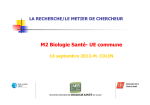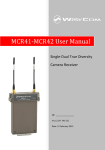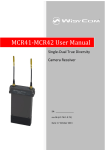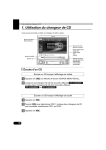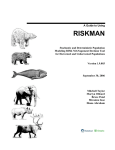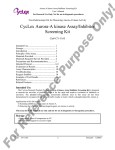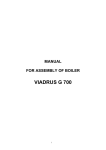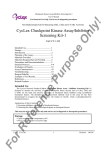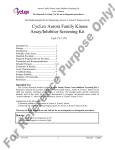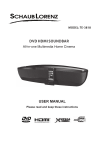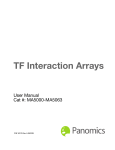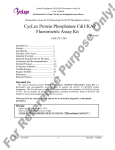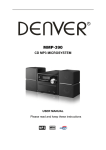Download Data Sheet
Transcript
ly ! Wee1 Kinase Assay/Inhibitor Screening Kit User’s Manual For Research Use Only, Not for use in diagnostic procedures On Non-Radioisotopic Kit for Measuring Wee1 Kinase Activity en ce Pu Intended Use................................................ 1 Storage......................................................... 1 Introduction ................................................. 2 Principle of the Assay.................................. 3 Materials Provided ...................................... 4 Materials Required but not Provided .......... 4 Precautions and Recommendations............. 5 Detailed Protocol......................................... 6-9 Evaluation of Results .................................. 10 Assay Characteristics .................................. 10 Troubleshooting .......................................... 10 Reagent Stability ......................................... 10 Example of Test Results.............................. 11 References.................................................... 12 Related Products.......................................... 13 rp Cat# CY-1172 os e CycLex Wee1 Kinase Assay/Inhibitor Screening Kit Intended Use The CycLex Research Product CycLex Wee1 Kinase Assay/Inhibitor Screening Kit is designed to measure the activities of purified Wee1 for the rapid and sensitive evaluation of inhibitors or activators. The phospho-tyrosine specific monoclonal antibody used in this assay kit has been demonstrated to recognize the phospho-tyrosine 15 residue in Cdc2, which is phosphorylated by Wee1. er Applications of this kit include: 1) Screening inhibitors or activators of Wee1 kinase. 2) Detecting the effects of pharmacological agents on Wee1 kinase activity in vitro. ef This assay kit is for research use only and not for use in diagnostic or therapeutic procedures. Storage rR • Upon receipt store all components at 4°C. • Don’t expose reagents to excessive light. Fo Cat#: CY-1172 1 Version#: 120420 On Introduction ly ! Wee1 Kinase Assay/Inhibitor Screening Kit User’s Manual For Research Use Only, Not for use in diagnostic procedures en ce Pu rp os e Wee1 kinase negatively regulates entry into mitosis by catalyzing the inhibitory tyrosine phosphorylation of Cdc2/cyclin B kinase (1). Antibody depletion experiments demonstrate that Wee1 accounts for most of the activity that phosphorylates Cdc2 on Tyr15 within the ATP-binding pocket of the Cdc2 catalytic subunit, in an in vitro assay of HeLa cell lysates (2, 3), hence it is likely to have an important role in the mitotic control of human cells. While, Myt1 is responsible for phosphorylation of another inhibitory threonine (Thr14) of Cdc2/cyclin B kinase (4). Wee1 kinase activity is strongly suppressed during M phase, suggesting that negative regulation of Wee1 could be part of the mechanism by which activation of Cdc2/cyclin B kinase is promoted during the G2/M transition. Wee1 activity increased during S and G2 phases in parallel with the level of protein, its activity decreased at M phase when Wee1 became transiently hyperphosphorylated (2, 3). In addition, a decrease in Wee1 protein level was observed at M/G1 phase (2, 3). Apparently, the hyperphosphorylation and degradation in combination caused inactivation of Wee1 at M phase and the following G1 phase (4). These results suggest that the activity of Wee1 is regulated by phosphorylation and proteolytic degradation, and that Wee1 plays a role in inhibiting mitosis before M phase by phosphorylating Cdc2/cyclin B kinase (1-3, 5). Mammalian cells undergo cell cycle arrest in response to DNA damage due to the existence of multiple checkpoint response mechanisms. One such checkpoint pathway operating at the G1 phase is frequently lost in cancer cells due to mutation of the p53 tumor suppressor gene. However, cancer cells often arrest at the G2 phase upon DNA damage, due to activation of another checkpoint pathway that prevents the activation Cdc2 kinase. The kinases, Wee1 and Chk1 are key regulators of this G2 checkpoint (6-10), which act directly or indirectly to inhibit Cdc2 activity. Inhibition of Wee1 and Chk1 sensitized only cancer cells, which lost G1 phase checkpoint, to DNA damage agents-induced apoptosis. These data support the attractiveness of Wee1 as well as Chk1 is as molecular targets for abrogating the G2 DNA damage checkpoint arrest, a situation that may selectively sensitize p53-deficient tumor cells to radiation or chemotherapy treatment. Measurement of Wee1 activity rR ef er The protocol generally regarded as most sensitive for the quantitative measurement of Wee1 activity involves incubation of the Wee1 sample with substrate, either a natural or synthetic polypeptide (such as wee1-tide; Cdc2-peptide), in the presence of Mg2+and 32P-labeled ATP. The reaction is terminated by "spotting" a sample onto a phospho-cellulose P81 filter paper disc, followed by washing extensively to remove unincorporated radiolabel and the radioactivity counted. While sensitive, this method is labor-intensive, generates hazardous radioactive waste and depends on a radioisotope of short half-life. It is particularly unsuitable when kinase assays are only performed on an infrequent basis. The CycLex Wee1 kinase Assay/Inhibitor Screening Kit uses peroxidase coupled anti-Phospho-Tyrosine monoclonal antibody as a reporter molecule in a 96-well ELISA format. This assay provides a non-isotopic, sensitive and specific method to measure the activities of Wee1 kinase. Fo Cat#: CY-1172 2 Version#: 120420 On Principle of the Assay ly ! Wee1 Kinase Assay/Inhibitor Screening Kit User’s Manual For Research Use Only, Not for use in diagnostic procedures rp os e The CycLex Research Product CycLex Wee1 kinase Assay/Inhibitor Screening Kit is a single-site, semi-quantitative immunoassay for Wee1 activity. Plates are pre-coated with a substrate corresponding to recombinant Cdc2, which contains tyrosine15 residues that can be phosphorylated by Wee1. The detector antibody specifically detects only the phosphorylated form of tyrosine15 residue on Cdc2. The CycLex Wee1 kinase Assay/Inhibitor Screening Kit can be used to study the kinetics of a purified or partially purified Wee1 as well as to screening Wee1 inhibitor. To perform the test, the sample is diluted in Kinase Buffer, pipetted into the wells and allowed to phosphorylate the bound substrate following the addition of Mg2+ and ATP. The amount of phosphorylated substrate is measured by binding it with a PY-39, an anti-Phospho-Tyrosine monoclonal antibody, followed by binding with horseradish peroxidase conjugated anti-mouse IgG, which then catalyzes the conversion of the chromogenic substrate tetra-methylbenzidine (TMB) from a colorless solution to a blue solution (or yellow after the addition of stopping reagent). The color is quantitated by spectrophotometry and reflects the relative amount of Wee1 activity in the sample. For kinetic analysis, the Wee1 containing sample is added to the wells in a similar fashion and at varying times the reaction is stopped by the addition of the chelator, sodium ethylenediaminetetraacetate (EDTA) and the amount of phosphorylated substrate determined as before. Pu Summary of Procedure Add 100 µL of sample to the wells Incubate for 60 min at 30°C en ce Wash the wells Add 100 µL of Anti-Phospho-Tyrosine antibody (PY-39) Incubate for 60 min at room temp. Wash the wells Add 100 µL of HRP conjugated anti-mouse IgG er Incubate for 60 min at room temp. Wash the wells ef Add 100 µL of Substrate Reagent rR Add 100 µL of Stop Solution Fo Cat#: CY-1172 Measure absorbance at 450 nm 3 Version#: 120420 On Materials Provided ly ! Wee1 Kinase Assay/Inhibitor Screening Kit User’s Manual For Research Use Only, Not for use in diagnostic procedures All samples and standards should be assayed in duplicate. The following components are supplied and are sufficient for the one 96-well microtiter plate kit. os e Microplate: One microplate supplied ready to use, with 96 wells (12 strips of 8-wells) in a foil, zip-lock bag with a desiccant pack. Wells are coated with recombinant Cdc2 as a Wee1 substrate. 10X Wash Buffer: One bottle containing 100 mL of 10X buffer containing 2 %Tween®-20 Kinase Buffer: One bottle containing 20 mL of 1X buffer; used for Kinase Reaction Buffer and sample dilution. 20X ATP: Lyophilized ATP Na2 salt. rp Anti-Phospho-Tyrosine Monoclonal Antibody (PY-39): One vial containing 12 mL of anti-phosphotyrosine. Ready to use. Pu HRP conjugated Anti-mouse IgG: One vial containing 12 mL of HRP (horseradish peroxidase) conjugated anti-mouse IgG. Ready to use. Substrate Reagent: One bottle containing 20 mL of the chromogenic substrate, tetra-methylbenzidine (TMB). Ready to use. Stop Solution: One bottle containing 20 mL of 1 N H2SO4. Ready to use. en ce Materials Required but not Provided rR ef er • Wee1 positive control: Available from CycLex (Wee1 positive control: Cat# CY-E1172) One vial contains 8 units/200 µL of Wee1 enzyme. The Positive control should be added to the first well at 40 m units/well. For instance, diluted positive control 1:10, use 10 µL for 1 assay. (Unused Wee1 enzyme should be stored in aliquots at below -70°C.) • Staurosporine (200 µM): Staurosporine is available from Sigma, Cat#. S-4400. 1 mM stock solution (DMSO) diluted 1:5 with Kinase Buffer. Even though final concentration of Staurosporine is 20 µM, kinase activity of Wee1 isn’t completely inhibited. See Fig.2. • Pipettors: 2-20 µL, 20-200 µL and 200-1000 µL precision pipettors with disposable tips. • Precision repeating pipettor • Wash bottle or multichannel dispenser for plate washing • Microcentrifuge and tubes for sample preparation • Vortex mixer • Plate reader capable of measuring absorbance in 96-well plates at dual wavelengths of 450 nm/540 nm. Dual wavelengths of 450/550 or 450/595 nm can also be used. The plate can also be read at a single wavelength of 450 nm, which will give a somewhat higher reading. • 500 or 1000 mL graduated cylinder • Reagent reservoirs • Deionized water of the highest quality • Disposable paper towels Fo Cat#: CY-1172 4 Version#: 120420 ly ! Precautions and Recommendations On Wee1 Kinase Assay/Inhibitor Screening Kit User’s Manual For Research Use Only, Not for use in diagnostic procedures • Store the Wee1 enzyme at below -70°C and the ATP at -20°C when not in use. Store all other components at 4°C. Do not expose reagents to excessive light. Avoid freeze/thaw cycles. • Allow all the components to come to room temperature before use. os e • All microplate strips that are not immediately required should be returned to the zip-lock pouch, which must be carefully resealed to avoid moisture absorption. • Do not use kit components beyond the indicated kit expiration date. • Use only the microtiter wells provided with the kit. rp • Rinse all detergent residue from glassware. • Use deionized water of the highest quality. Pu • Do not mix reagents from different kits. • The buffers and reagents used in this kit contain either sodium Kathon-CG as preservatives. Care should be taken to avoid direct contact with these reagents. • Do not mouth pipette or ingest any of the reagents. en ce • Do not smoke, eat, or drink when performing the assay or in areas where samples or reagents are handled. • Dispose of tetra-methylbenzidine (TMB) containing solutions in compliance with local regulations. • Avoid contact with Substrate Solution which contains hydrogen peroxide. • Avoid contact with Stop Solution which contains Sulfuric Acid. er • In case of contact with the Stop Solution and the Substrate Solution, wash skin thoroughly with water and seek medical attention, when necessary. • Biological samples may be contaminated with infectious agents. Do not ingest, expose to open wounds or breathe aerosols. Wear protective gloves and dispose of biological samples properly. rR ef • CAUTION: Sulfuric Acid is a strong acid. Wear disposable gloves and eye protection when handling Stop Solution. Fo Cat#: CY-1172 5 Version#: 120420 On Detailed Protocol ly ! Wee1 Kinase Assay/Inhibitor Screening Kit User’s Manual For Research Use Only, Not for use in diagnostic procedures os e The CycLex Wee1 kinase Assay /Inhibitor Screening Kit is provided with removable strips of wells so the assay can be carried out on separate occasions using only the number of strips required for the particular determination. Since conditions may vary, running an aliquot of the appropriate Wee1 positive control (Cat# CY-E1172), separately available from CycLex, should be included in each assay. Disposable pipette tips and reagent troughs should be used for all transfers to avoid cross-contamination of reagents or samples. Preparation of Working Solution 1. Prepare a working solution of Wash Buffer by adding 100 mL of the 10X Wash Buffer (provided) to 900 mL of ddH2O. Mix well. Store at 4°C for two weeks or -20°C for long-term storage. rp 2. Prepare 20X ATP Solution by adding 0.8 mL of ddH2O to the vial of 20X ATP (provided, lyophilized). Mix gently until dissolved. The final concentration of the 20X ATP Solution should be 2.5 mM. Store the solution in small aliquots (e.g. 100 µL) at -20°C. Kinase Buffer (provided) 20X ATP (provided) 96 assays 10 assays 1 assay 9.5 mL 0.5 mL 950 µL 50 µL 95 µL 5 µL 10 mL 1000 µL 100 µL en ce Total Pu 3. Prepare Kinase Reaction Buffer by mixing following reagents. You will need 80-90 µL of Kinase Reaction Buffer per assay well. Mix well. Discard any unused Kinase Reaction Buffer after use. Standard Assay 1. Remove the appropriate number of microtiter wells from the foil pouch and place them into the well holder. Return any unused wells to the foil pouch, refold, seal with tape and store at 4°C. er 2. Prepare all samples (diluted with Kinase Buffer as needed). All samples should be assayed in duplicate. ef 3. Duplicate wells containing 10 µL of Wee1 positive control (40 m units) should be included in each assay as a positive control for phosphorylation. 4. Begin the kinase reaction by addition of 90 µL Kinase Reaction Buffer per well, cover with plate sealer or lid, and incubate at 30°C for 60 minutes. rR 5. Wash wells four times with Wash Buffer making sure each well is filled completely. Remove residual Wash Buffer by gentle tapping or aspiration. 6. Pipette 100 µL of Anti-Phospho-Tyrosine Monoclonal Antibody PY-39 into each well, cover with plate sealer or lid, and incubate at room temperature (ca.25°C) for 60 minutes. Discard any unused antibody after use. Fo Cat#: CY-1172 6 Version#: 120420 ly ! On Wee1 Kinase Assay/Inhibitor Screening Kit User’s Manual For Research Use Only, Not for use in diagnostic procedures 7. Wash wells four times as same as in step 5. 8. Pipette 100 µL of HRP-conjugated Anti-mouse IgG into each well, cover with plate sealer or lid, and incubate at room temperature (ca.25°C) for 60 minutes. Discard any unused conjugate after use. os e 9. Wash wells five times as same as in step 5. 10. Add 100 µL of Substrate Reagent to each well and incubate at room temperature (ca.25°C) for 5–15 minutes. 11. Add 100 µL of Stop Solution to each well in the same order as the previously added Substrate Reagent. Pu rp 12. Measure absorbance in each well using a spectrophotometric plate reader at dual wavelengths of 450/540 nm. Dual wavelengths of 450/550 or 450/595 nm can also be used. Read the plate at 450 nm if only a single wavelength can be used. Wells must be read within 30 minutes of adding the Stop Solution. Note-1: Complete removal of liquid at each step is essential to good performance. After the last wash, remove any remaining Wash Buffer by aspirating or decanting. Invert the plate and blot it against clean paper towels. en ce Note-2: Reliable signals are obtained when either O.D. values do not exceed 0.3 for the blank (no enzyme control), or 1.5 for the Wee1 positive control. Note-3: If the microplate reader is not capable of reading absorbance greater than the absorbance of the Wee1 positive control, perform a second reading at 405 nm. A new O.D. values, measured at 405 nm, is used to determine Wee1 activity of off-scale samples. The readings at 405 nm should not replace the on-scale readings at 450 nm. Kinetic Assays er 1. Remove the appropriate number of microtiter wells from the foil pouch and place them into the well holder. Return any unused wells to the foil pouch, refold, seal with tape and store at 4°C. 2. Prepare all samples (diluted with Kinase Buffer as needed). All samples should be assayed in duplicate. ef 3. Duplicate wells containing 10 µL of Wee1 positive control (40 m units) should be included in each assay as a positive control for phosphorylation. rR 4. Begin the kinase reaction by addition of 90 µL of Kinase Reaction Buffer in duplicate per well in timed intervals (suggested interval is 5 minutes but should be individually determined for each system). After the final addition, cover with plate sealer or lid, and incubate at 30°C for 40 minutes. 5. Stop the reaction by flicking out the contents. (Alternatively, the reaction may be terminated by the addition of 150 µL 0.1 M Na EDTA, pH 8.0 to each well). Fo Cat#: CY-1172 7 Version#: 120420 ly ! Wee1 Kinase Assay/Inhibitor Screening Kit User’s Manual For Research Use Only, Not for use in diagnostic procedures On 6. Wash wells four times with Wash Buffer making sure each well is filled completely. Remove residual Wash Buffer by gentle tapping or aspiration. 7 Pipette 100 µL of Anti-Phospho-Tyrosine Monoclonal Antibody PY-39 into each well, cover with plate sealer or lid, and incubate at room temperature (ca.25°C) for 60 minutes. Discard any unused antibody after use. os e 8. Wash wells four times as same as in step 5. 9. Pipette 100 µL of HRP-conjugated Anti-mouse IgG into each well, cover with plate sealer or lid, and incubate at room temperature (ca.25°C) for 60 minutes. Discard any unused conjugate after use. 10. Wash wells five times as same as in step 5. rp 11. Add 100 µL of Substrate Reagent to each well and incubate at room temperature for 5-15 minutes. Pu 12. Add 100 µL of Stop Solution to each well in the same order as the previously added Substrate Reagent. 13. Measure absorbance in each well using a spectorphotometric plate reader at dual wavelengths of 450/540 nm. Dual wavelengths of 450/550 or 450/595 nm can also be used. Read the plate at 450 nm if only a single wavelength can be used. Wells must be read within 30 minutes of adding the Stop Solution. en ce Recommendations Special considerations when screening activators or inhibitors In order to estimate the inhibitory effect on individual Wee1 activity in the test chemicals correctly, it is necessary to conduct the control experiment of “Solvent control” at least once for every experiment and “Inhibitor control” at least once for the first experiment, in addition to “Test sample”, as indicated in the following table. When test chemicals cause an inhibitory effect on Wee1 activity, the level of A450 is weakened as compared with “Solvent control”. The high level of A450 is not observed in “Inhibitor control” (usually A450<0.4). Test sample Kinase Reaction Buffer* 80 µL Solvent control 80 µL 10X Inhibitor or equivalent 10 µL - - Solvent for Inhibitor - 10 µL - 10X Staurosporine (200 µM) ** - - 10 µL 10 µL 10 µL 10 µL ef er Assay reagents rR Wee1 positive control (4 m units/uL)*** or your enzyme fraction Inhibitor control 80 µL * Kinase Reaction Buffer: See Page 6, section “Preparation of Working Solution” ** Cat# S-4400: See Page 4, section “Materials Required but not Provided”. Even though final concentration of Staurosporine is 20 µM, kinase activity of Wee1 isn’t completely inhibited. See Fig.2. *** Wee1 positive control: Cat# CY-E1172: See Page 4, section “Materials Required but not Provided” Fo Cat#: CY-1172 8 Version#: 120420 ly ! Wee1 Kinase Assay/Inhibitor Screening Kit User’s Manual For Research Use Only, Not for use in diagnostic procedures On 1. Following the above table, add the Reagents to each well of the microplate. Finally, initiate reaction by adding 10 µL of “Wee1 positive control” to each well and mixing thoroughly at room temperature. Cover with plate sealer or lid, and incubate at 30°C for 60 minutes. 2. Follow the Standard Assay steps 5-12, page 6-7. Kinase Reaction buffer* Test Sample 90 µL - 10X Staurosporine (200 µM) ** - Your enzyme fraction Wee1 positive control (4 m units/uL)*** Buffer ATP minus control - Positive control 90 µL No enzyme control 90 µL - 90 µL - - 10 µL - - - 10 µL - 10 µL - 10 µL Pu Kinase Buffer (ATP minus) Inhibitor control 80 µL rp Assay reagents os e Special considerations when measuring precise Wee1 activity In order to measure the activity of Wee1 correctly, it is necessary to conduct the control experiment of “Inhibitor control” at least once for every experiment and “ATP minus control” at least once for the first experiment, in addition to “No enzyme control” as indicated in the following table. Although the level of A450 increases in “Test sample” when Wee1 enzyme activity is in the sample, the high level of A450 is not observed in “Inhibitor control”, “ATP minus control” and “No enzyme control”. 10 µL - 10 µL - en ce * Kinase Reaction Buffer: See Page 6, section “Preparation of Working Solution” ** Cat# S-4400: See Page 4, section “Materials Required but not Provided”. Even though final concentration of Staurosporine is 20 µM, kinase activity of Wee1 isn’t completely inhibited. See Fig.2. ***Wee1 positive control: Cat# CY-E1172: See Page 4, section “Materials Required but not Provided” 1. Following the above table, add the Reagents to each well of the microplate. Finally, initiate the reaction by adding 10 µL of “Your enzyme fraction” or “Buffer” to each well and mixing thoroughly at room temperature. Cover with plate sealer or lid, and incubate at 30°C for 60 minutes. rR ef er 2. Follow the Standard Assay steps 5-12, page 6-7. Fo Cat#: CY-1172 9 Version#: 120420 On Evaluation of Results ly ! Wee1 Kinase Assay/Inhibitor Screening Kit User’s Manual For Research Use Only, Not for use in diagnostic procedures 1. Average the absorbance values for the Wee1 sample duplicates (positive control) and all experimental sample duplicate values (when applicable). When Wee1 positive control (40 m units/assay) is included as an internal control for the phosphorylation reaction, the absorbance value should be greater than 1.5 with a background less than 0.3. os e 2. For screening of purification/chromatography fractions, on graph paper, plot the mean absorbance values for each of the samples on the Y-axis versus the fraction number on the X-axis to determine the location of the eluted, purified Wee1. 3. For kinetic analysis, on graph paper, plot the mean absorbance values for each of the time points on the Y-axis versus the time of each reaction (minutes) on the X-axis. rp Troubleshooting Pu 1. The CycLex Wee1 positive control (Cat# CY-E1172) should be run in duplicate, when a standard assay is being performed, using the protocol described in the “Detailed Protocol”. Incubation times or temperatures significantly different from those specified may give erroneous results. 2. The reaction curve is nearly a straight line if the kinetics of the assay is of the first order. Variations in the protocol can lead to non-linearity of the curve, as can assay kinetics of other than first order. For a non-linear curve, point to point or quadratic curve fit methods should be used. en ce 3. Poor duplicates, accompanied by elevated values for wells containing no sample, indicate insufficient washing. If all instructions in the “Detailed Protocol” were followed accurately, such results indicate a need for washer maintenance. 4. Overall low signal may indicate that desiccation of the plate has occurred between the final wash and addition of Substrate Reagent. Do not allow the plate to dry out. Add Substrate Reagent immediately after wash. Reagent Stability er All of the reagents included in the CycLex Research Product CycLex Wee1 kinase Assay/Inhibitor Screening Kit have been tested for stability. Reagents should not be used beyond the stated expiration date. Upon receipt kit reagents should be stored at 4°C, except the ATP must be stored at -20°C. Coated assay plates should be stored in the original foil bag sealed by the zip lock and containing a desiccant pack. rR ef For research use only, not for use in diagnostic or therapeutic procedures Fo Cat#: CY-1172 10 Version#: 120420 On Example of Test Results Fig.1 Dose dependency of recombinant Wee1 enzyme reaction 3.0 os e 2.5 2.0 1.5 rp A450 ly ! Wee1 Kinase Assay/Inhibitor Screening Kit User’s Manual For Research Use Only, Not for use in diagnostic procedures 1.0 0.0 0 5 10 15 20 Pu 0.5 25 30 35 40 en ce Wee1 (m units/100 ul reaction) Fig.2 Effect of broad-spectrum kinase inhibitor staurosporine on Wee1 activity 120% 80% er Intensity (% of Conrol) 100% 60% ef 40% rR 20% 0% 0.001 Fo Cat#: CY-1172 0.010 0.100 1.000 10.000 100.000 Staurosporine Conc. (uM) 11 Version#: 120420 1. Nurse, P. Checkpoint pathways come of age. Cell 91:865-867, 1997 On References ly ! Wee1 Kinase Assay/Inhibitor Screening Kit User’s Manual For Research Use Only, Not for use in diagnostic procedures 2. Watanabe, N., M. Broome, and T. Hunter. Regulation of the human WEE1Hu CDK tyrosine 15-kinase during the cell cycle. EMBO J. 14:1878-1891, 1995 os e 3. McGowan, C. H., and P. Russell. Cell cycle regulation of human Wee1. EMBO J. 14:2166-2175, 1995 4. Mueller PR, Coleman TR, Kumagai A, Dunphy WG. Myt1: a membrane-associated inhibitory kinase that phosphorylates Cdc2 on both threonine-14 and tyrosine-15. Science. 270:86-90, 1995 5. Michael, W. M., and J. Newport. Coupling of mitosis to the completion of S phase through Cdc34-mediated degradation of Wee1. Science 282:1886-1889, 1998. rp 6. Shi, L., W. K. Nishioka, J. Th'ng, E. M. Bradbury, D. W. Litchfield, and A. H. Greenberg. Premature p34cdc2 activation required for apoptosis. Science 263:1143-1145, 1994 Pu 7. Leach, S. D., C. D. Scatena, C. J. Keefer, H. A. Goodman, S. Y. Song, L. Yang, and J. A. Pietenpol. Negative regulation of Wee1 expression and Cdc2 phosphorylation during p53-mediated growth arrest and apoptosis Cancer Res. 58: 3231 – 3236, 1998 8. Yuan,H., Xie,Y.M. and Chen,I.S. Depletion of Wee-1 kinase is necessary for both human immunodeficiency virus type 1 Vpr- and gamma irradiation-inducedapoptosis J. Virol. 77 (3), 2063-2070, 2003 en ce 9. Heald, R., M. McLoughlin, and F. McKeon. Human wee1 maintains mitotic timing by protecting the nucleus from cytoplasmically activated Cdc2 kinase. Cell 74:463-474, 1993 rR ef er 10. Jackson JR, Gilmartin A, Imburgia C, Winkler JD, Marshall LA, Roshak A. An indolocarbazole inhibitor of human checkpoint kinase (Chk1) abrogates cell cycle arrest caused by DNA damage. Cancer Res. 60(3):566-72, 2000 Fo Cat#: CY-1172 12 Version#: 120420 On Related Products ly ! Wee1 Kinase Assay/Inhibitor Screening Kit User’s Manual For Research Use Only, Not for use in diagnostic procedures os e * Wee1 Positive control: Cat# CY-E1172 * CycLex Protein Phosphatase Cdc25A Fluorometric Assay Kit: Cat# CY-1352 * CycLex Protein Phosphatase Cdc25B Fluorometric Assay Kit: Cat# CY-1353 * CycLex Protein Phosphatase Cdc25C Fluorometric Assay Kit: Cat# CY-1354 * CycLex Protein Phosphatase Cdc25 Combo Fluorometric Assay Kit: Cat# CY-1355 Pu CycLex Co., Ltd. 1063-103 Terasawaoka Ina, Nagano 396-0002 Japan Fax: +81-265-76-7618 e-mail: [email protected] URL: http://www.cyclex.co.jp rp PRODUCED BY rR ef er en ce CycLex/CircuLex products are supplied for research use only. CycLex/CircuLex products and components thereof may not be resold, modified for resale, or used to manufacture commercial products without prior written approval from CycLex Co., Ltd.. To inquire about licensing for such commercial use, please contact us via email. Fo Cat#: CY-1172 13 Version#: 120420















